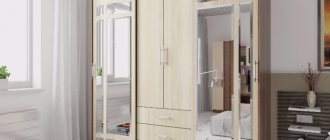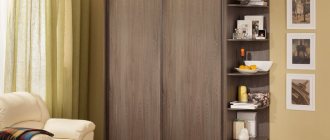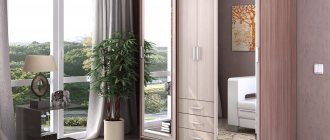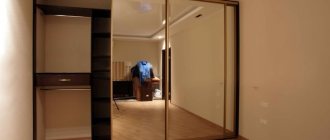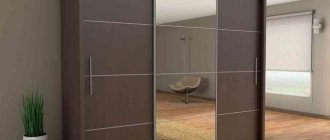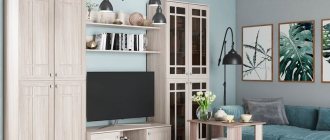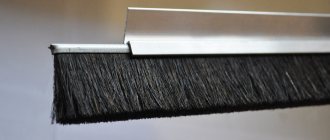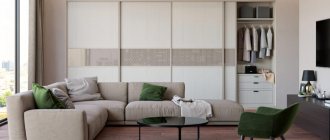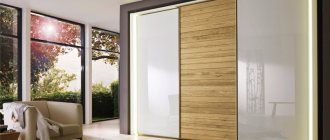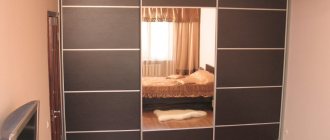In small rooms, installing a wardrobe up to the ceiling is becoming increasingly popular. And it’s not surprising, because compared to a traditional cabinet, its useful volume is twice as large. The whole point is a clever door system that saves space for opening. The design of the product can be anything, allowing it to fit into different bedroom interiors. It is made depending on the size of the room, but there are a number of nuances.
The design of the product can be anything, allowing it to fit into different bedroom interiors.
Non-standard solutions when installing a cabinet
Don’t think that all you can install in a narrow hallway is just a built-in wardrobe.
You can play around with it in such a way as to install an ordinary wardrobe and connect it with an interior partition. One of the doors may well serve as a door. Inside this part of the cabinet you can install beautiful closed or, conversely, open shelves - any to your taste. Despite your unique solutions, a wardrobe in a small hallway should not be massive. For example, in order to place outerwear in it, its depth of 45–50 centimeters will be enough for you. This will help you save about twenty centimeters in the width of the hallway, despite the fact that the hangers will need to be placed in the frontal plane.
If your corridor is very narrow, even these insignificant 20 centimeters will play a big role.
Features of placing a full-wall cabinet in the living room
The important point is the correct placement. The wall should not clutter up the space, and all modules should be accessible.
All elements of furniture should be arranged so that it is convenient for the owners to use them and at the same time not go beyond the general style of the room.
For the arrangement to be harmonious, it must be done from the window, taking into account the rules of symmetrical or asymmetrical arrangement.
Under no circumstances should such furniture be placed against a wall with a window. It will not have a complete appearance.
It is better if the wall, slide or compartment is on the wall opposite the window.
Ideally, it is better to install furniture along the longest wall; thanks to this arrangement and mirrored facades, the room will visually appear wider and more spacious.
If the room is not wide, then it is better to occupy the end wall opposite the window. The only point that needs to be taken into account with this arrangement is that the doorway must be at a sufficient distance from the corner so as not to block it.
Advantages and disadvantages of a built-in wardrobe
How to make a wardrobe with your own hands, drawings, assembly steps and photos of beautiful works.
A built-in wardrobe allows you to make the most of every occupied meter of the hallway. Made to order, it fits perfectly into the space. The owners themselves decide how long and deep the built-in furniture will be and how many doors it will have.
What other advantages can be found in such a model?
- The built-in wardrobe has a large capacity. It is mounted up to the ceiling of the hallway, and accordingly, the storage area increases in height.
- A model with doors that open according to the compartment principle saves corridor space. Ordinary doors require a free adjacent area.
- The built-in storage system will fit perfectly into any design style. Depending on the chosen direction, the cabinet facades are designed.
- The design of the furniture is reliable and simple. It is tightly attached to the walls, and the doors open and close, moving on rollers along the bar. It may be enough to periodically monitor the condition of the roller mechanism.
- Built-in wardrobes are economical to manufacture. If such a structure is mounted in a niche, then it is often enough to make a frame for the doors and the doors themselves. In any case, you can spend less on materials for the back and top walls of the cabinet.
- The cost of the cabinet is not higher than the price of a similar model of cabinet furniture. But there are so many advantages!
A built-in wardrobe is not built for one year. Therefore, the disadvantage of this model is that it cannot be moved to another place. You will have to either completely dismantle the entire structure or get used to it. As a last resort, you can change the facades to others, thereby giving the corridor a new look.
Device and types
It is not known for certain who invented such a cabinet, but according to one version, Napoleon Bonaparte is considered its founder. It was he, concerned about the disorder in the apartments of his officers, who ordered them to put their things in one place, covering them with a screen from prying eyes. In this case, things had to be placed on special stages.
The design was further developed in America. The inventor, whose name is unknown, came up with the idea of installing the screen on wheels placed on a special bar. This gave the structure stability. This was practically a revolution in the world of doors, since they opened not towards themselves, but to the side.
The following years constantly brought various improvements. The screen was replaced with a blank board, and then with glass and a mirror. The plank changed its appearance in such a way that it allowed the wheels to move along it almost silently and not jump off. A special film was glued to the mirror and glass, making them resistant to vibrations and light impacts.
In the territory of the former USSR, the first sliding wardrobes appeared in 1995. Such designs were very expensive and aimed at wealthy people. Stanley aluminum profile or Neves steel profile was used as guides. By the end of the 90s, the export of components to the country increased, allowing one to assemble the sliding system independently. The most popular profiles are from Versal and Raumlus. Due to increased competition, prices for components eventually fell, which led to a significant reduction in the price of the cabinet as a whole.
A sliding wardrobe is a structure placed in a dead-end part of the apartment in front of the wall and occupying space from ceiling to floor.
Today, technology and the availability of components make it possible not only to hire specialists, but also to assemble a wardrobe with your own hands from floor to ceiling, creating, as it were, a false wall. Consumers take advantage of this opportunity. For example, having removed the facades from obsolete Polish, Soviet and other furniture walls that were very popular in the USSR, they are covered with a mirror sliding system, thereby increasing the attractiveness of the interior without changing the usual order of things.
System design
A sliding wardrobe is a structure placed in a dead-end part of the apartment in front of the wall and occupying space from ceiling to floor. A distinctive feature of the product is the opening of the door by sliding it along a horizontal guide. Between the door and the wall there are racks, shelves or drawers designed to store all kinds of objects and things. Thus, the cabinet is continuous along the entire length and height of the wall.
Sliding wardrobes are classified by type of location. They can be located in a niche, at the dead end of a corridor, in the corner of a room. That is, in fact, they are divided into angular and straight. It should be noted that recently their classic location in a dead end is not always used, but their use as a dividing wall is becoming popular.
The facade is called an insert and can be either the same type or combined.
The door system includes the following elements:
- top guide - W-shaped profile that serves to guide the rollers when the door moves;
- horizontal and vertical strip - creates a frame into which the door facade is inserted;
- lower profile - serves as the lower base of the door;
- bracket with roller - attached to the lower profile;
- double guide - located on the floor of the room and is designed for the lower rollers to move along it.
In other words, the entire door is assembled in a profile, which is often also a handle. Rollers are attached to it from below. This door frame fits into tracks that are screwed to the ceiling and floor. In this case, the floor one has two parallel rails. One door moves along one, and another door moves along the other , thereby moving in the same plane, they do not interfere with each other.
Material for production
The profile is made of steel (stainless steel) or aluminum. The first option is slightly preferable, although more expensive. The facade is called an insert and can be either the same type or combined. To separate it, slats are used. The following is mainly used as an insert:
- Laminated chipboard is a chipboard coated with a special film that imitates various materials, such as marble, wood, brick. It is made by pressing sawdust with the addition of a binder (organic glue). LDSP is a chipboard coated with a special film that imitates various materials.
- Glass - sheet glass is used, obtained at high temperatures followed by rapid cooling. As a result, mechanical stresses are formed, increasing strength. Sheet glass is used, obtained at high temperatures followed by rapid cooling.
- Mirror - tempered glass is used with a sprayed reflective coating, to which bronze and paint can be added. Designs can be applied to its surface using sandblasting.
Tempered glass is used with a reflective coating, which can contain bronze and paint. - Plastic - various types of polymers with varying degrees of transparency are used. Sliding wardrobe made of plastic.
- Rattan is obtained by weaving tropical vines and then impregnating them with varnish. Rattan wardrobe.
- Bamboo - consists of bamboo stems tightly connected to each other with glue or tightly packed into the door frame. Sliding wardrobe made of bamboo.
- Lacobel (LACOBEL) - opaque multi-colored glass (stained glass). Usually only one side of the surface is painted. Lakobel is an opaque multi-colored glass.
Everything that is behind the door is called filling. It is usually made from laminated chipboard or aluminum and includes all kinds of sizes: shelves, drawers, crossbars, hooks, pantographs and similar elements.
Beautiful examples in the interior
Choosing a sliding wardrobe or a hinged wardrobe
The second half of the last century was characterized by the construction of the so-called “Khrushchev buildings”. A huge number of families who once lived in communal apartments suddenly acquired their own living space. Architects of that time did not think much about the size of the hallway, and it was because of this that housewives were deprived of their own corner. Modern designers have been able to solve this problem, and now many cabinets in the hallway are equipped with a dressing table and ottoman.
Many people think that the purpose of a closet in a small hallway is purely practical. And they don't consider furniture from an aesthetic point of view. But modern materials allow you to play with space in the right way.
If there is an empty niche in the apartment, then you can make a spacious dressing room out of it. On the one hand, you can remove all outer clothing from prying eyes, and on the other hand, all communications, including telephone wires and cable television wires.
If there is no niche in the apartment, you can always find a place for a bedside table or chest of drawers in addition to the closet. A free-standing hanger for light outerwear also looks beautiful.
If you have a long corridor, purposefully install a wardrobe with a mirror on swing doors. Thanks to this placement, the space even in a narrow corridor visually doubles.
Give preference to light colors. Remember that if you have a closet made in dark colors, additional lighting is necessary, otherwise the hallway will resemble a closet.
Remember that cabinets with open storage systems require not only careful surface care, primarily wet and dry cleaning, but also seasonal renewal of items. Winter clothes hanging on a hanger in the summer will look absurd. Therefore, it is advisable to have additional wardrobes or closets for storing unused outerwear.
If the space in the hallway allows you to place an umbrella stand, then by all means take advantage of it. Firstly, it will complement the design of the decor, and, secondly, it will allow you not to forget the umbrella in cloudy weather. Additional space for storing various small items - a bunch of keys, newspapers or advertising flyers and business cards - would also be useful.
In many apartments, power meters have been moved from the landing to their own corridor. Intercom tubes have been installed, and in some places security equipment has been installed. Thanks to the cabinet in the hallway, all wires and sensors can be easily hidden from the eyes of guests.
The main problem of small hallways is the limited space for furniture. Most of the proposed solutions sold in furniture stores are not suitable for a small hallway. But the buyer always has the choice and opportunity to assemble his own hallway, adhering to the general style of the room. The key in a small hallway will always be a closet.
Remember that in addition to the functional component, aesthetic appearance also plays an important role in this matter. It’s not for nothing that people say that people are greeted by their clothes, from which one can easily conclude that an opinion about the owner of an apartment is made by his hallway.
You will learn more about how to choose a cabinet for a small hallway in the following video.
Corner wardrobe in the bedroom: 5 best examples of shapes for furnishing a corner
view album in new window
In the photo: Built-in wardrobe for the bedroom in white to order
Next, let's look at different options for bedroom wardrobes, which are placed in the corner next to the bed. They do not necessarily have to have a corner module. As a rule, this form looks bulky and does not look very neat. The only exceptions are light designer models. Therefore, for the corner, we advise you to choose a straight wardrobe or a large hinged wardrobe.
Neoclassical bedroom design with large built-in wardrobe with drawers
view album in new window
In the photo: Bedroom wardrobe with drawers below
This idea is ideal for the wall opposite the bed. Both corners are used for storing clothes. The cabinets can be divided between spouses, which will be very convenient. But this bedroom also has a built-in closet on the left (you can only see it a little in the photo above), so these closets can be used for seasonal or additional storage. The amazing drawers in two rows along the entire length deserve special attention, allowing you to conveniently store a million things in order and exceptional cleanliness. In the center is a TV module that can be hung on the wall or placed on a shelf, your choice.
Interior of a bright bedroom in the style of modern classics with American integrated furniture
view album in new window
In the photo: Fashionable bedroom interior in the style of modern classics
Another very good option is American built-in furniture made from natural wood. Such furniture has different modules: in addition to the closet, there are racks, shelves, and drawers. Typically, furniture in the same color and style of facades in one project can be found in the hallway, living room, dining room, bedroom and children's room, office, and sometimes even in the bathroom and on the loggia. With this approach, the apartment or house turns out to be decorated in a unified American style.
Built-in small wardrobe in a niche in the bedroom
view album in new window
In the photo: Built-in bedroom furniture in white
For a small standard bedroom in a new building or panel, we recommend an option with a bed almost in the center of the long wall. Near the window or on the attached loggia (and better yet, behind a small plasterboard partition), we recommend equipping a workplace with shelves, lighting and a soft half-chair.
Opposite such an office there is a built-in wardrobe (for books, additional things, seasonal storage). To the left (or right, depending on the layout) of the bed - closer to the front door - there is a built-in wardrobe up to the ceiling, which has a plasterboard partition on the side.
To decorate a small bedroom, we recommend: light walls, mirrors, high plinths and ceiling cornices, a chandelier socket and a backlit ceiling. It is better to choose elegant small bedside tables and a headboard with a geometric print. With such a set of furniture, a small room will be both cozy and multifunctional.
Art Deco style wardrobe with beautiful mirrored doors
view album in new window
In the photo: Fashionable ornaments in the design of built-in furniture facades
This option for a large closet is ideal for a long wall that can be completely dedicated to a dressing room. And on the left there is a place for a cocktail chair, which creates a boudoir atmosphere in the room.
Selection rules
Choosing lamps for the hallway
However, most of the positive qualities are lost when the outer laminated coating is damaged, so in this case, over time, the entire part will have to be replaced. It is also not recommended to heavily load long shelves and carefully drive in nails that do not hold well in such material.
When choosing, it is necessary to control the quality of the material, as it may contain harmful resins.
MDF is a denser and harder material, but contains harmful resin compounds that can only be neutralized by a sealed coating.
Wood is the most environmentally friendly material, allowing you to create slabs of any size, but when exposed to temperature and humidity it can become deformed and has a high price.
Door panels
One option is vinyl doors, which are lightweight, allowing the panels to slide well when moving. Combined with aluminum frames, the design has a stylish look.
One of the common solutions is the choice of mirrored doors, which help to create an imaginary increase in space even in small rooms. Colorless frosted glass is also gaining popularity as a material.
If, despite the variety of models, a more individual approach is required, it is possible to order doors for painting, then you can independently bring the cabinet to a finished look that best suits the interior.
Built-in wardrobe in the hallway
built-in wardrobes in the hallway always stand out
, because, in essence, this is not exactly a piece of furniture, it is a corridor space, separated from the steel part using a sliding partition, while inside it there are either convenient floors with drawers, or a whole dressing room, which you can enter completely and in comfort search for the necessary things.
The advantages of embedded systems over classical ones is that they are able to master the space of any configuration. If you have niches, columns, corners and other architectural shortcomings, then with the help of drywall and a sliding system you can even turn this disadvantage into a huge advantage with your own hands.
There are supporters of installing
a built-in wardrobe in the hallway
even at the stage of renovation work. It is believed that this way you can best fit it into the geometry of the room.
But, if we think from the point of view of the sequence of repair work, then the construction of a plasterboard box, partition and installation of guides can be carried out at any time without prejudice to other processes. The only exception may be systems for which the guides are literally recessed into the floor surface and the doors slide above its surface. Then yes, it is better to carry out such installation when you are laying floors.
The second point that you will need to calculate is the configuration and size of your future piece of furniture. Models of built-in wardrobes in the hallway, photo
which you can see are quite diverse and can occupy both a small space and the entire width (or even length) of the corridor.
In fact, it is worth assessing whether you need such a large amount of storage space, whether it would be advisable to spend that kind of money on a huge wardrobe, or whether you can get by with its more modest-sized counterpart. In this case, you can not only save money, but also come up with a more interesting design for the corridor, bring in additional elements that otherwise simply may not fit. There are also size limitations from the technical side of the issue. For example, despite the beauty and ease of use, you should not make horizontal shelves longer than 60 centimeters. If they are of a standard width, then exceeding the maximum size when fully loaded may result in deformation of the material, or even breakage of the entire shelf. The same can be said about drawers; drawers that are too deep and wide are sometimes mercilessly loaded and cannot withstand such weight. Therefore, it cannot always be said that a large wardrobe is better than medium-sized furniture.
Built-in wardrobe in the hallway photo
Let's look at some successful examples of the design of a built-in wardrobe in the hallway, photo
which reflect fashion trends and an excellent combination of beauty and functionality.
In the first photo, the structure occupies the entire wall, but does not look bulky and does not distract the main attention. The secret of success is not only in the correctly selected texture for the facade, namely matte milky white, even shades, but also in the central niche, decorated in a classic style
Thanks to this, there is an excellent place for putting on shoes, and at the same time, the room looks very stylish.
In the second option, a mirror texture is used for the doors on one leaf, and the second, in contrast, is made matte with a pattern applied.
Reflected in the mirror, the bright details of the furniture – a shelf and a chest of drawers in a fresh lemon tone – attract even more attention. A matte surface combined with natural wood is a truly win-win option, and the third photo proves this to us.
We don’t need a mirror, it’s better to hang it in a beautiful frame opposite, but a facade that looks neat and respectable will always be at a premium. And in the last example, you can see an illustration of the use of both a built-in large wardrobe and a free-standing wardrobe in one space. Despite the spaciousness and impressive dimensions of the entrance area, the use of a sliding system will be justified; it is convenient, practical, and looks very beautiful.
Wardrobe with mezzanine
A closet with a mezzanine is considered a good solution. Its overall height remains the same, but due to the isolation of the upper part, assembly is facilitated and the permissible load on long shelves increases.
Such a cabinet can be made to cover the entire wall, and it will not look bulky. Mezzanine doors with a cabinet depth of more than 0.5 m can be made as desired: hinged or compartment doors. With a shallower depth, it is better to make facades on hinges, so as not to give up extra centimeters for installing guides.
When the cabinet height is more than 2.7 m, sliding mezzanine doors are safer and more convenient than hinged ones.
If the ceiling height is 3 meters or more, the upper part remains difficult to access with any design. Therefore, it is better to store rarely used items there. But designers are working to solve this problem, and a number of elements have already been presented that simplify access to high-lying objects. For example, a pantograph helps to lower hanging clothes down and bring them back.
Ceiling finishing
Design
Often the design of the ceiling in the hallway fades into the background. This is in vain, because it is known that with the help of modern design techniques you can hide multiple flaws and unevenness of the ceiling.
For example:
- If the ceiling is low, then it is better to make it light in order to visually raise the ceilings.
- If the ceiling is high, then it is better to do it in dark colors to give comfort and harmony to the room.
- By choosing the appropriate method for finishing the ceiling surface and doing everything as planned, you can noticeably change the visualization of the same area of the room.
Before decorating the ceiling surface, you should think carefully about how to implement the designer’s intended solution into reality, because the room can be radically transformed.
Finishing methods
When carrying out ceiling repairs in the hallway, it is worth deciding on the methods of finishing it, which is now at the peak of popularity:
Whitewashing the ceiling - this finishing method is the simplest and one of the most budget-friendly. Before whitewashing, the ceiling must be plastered, because this is the only way to hide the unevenness of the ceilings. An old-fashioned finishing method, but if the budget is minimal, then the solution is very acceptable.
A wallpapered ceiling is a costly method, but at the same time economical. Depends on the wallpaper you plan to use. By choosing the right wallpaper, you can significantly change the configuration of the hallway.
Ceiling tiles are a common option. Using tiles, you can finish the ceiling without preliminary preparation. If you need to create a ceiling in the shortest possible time, then tiles are the ideal option.
The suspended ceiling in the hallway requires some installation skills, but with just such a ceiling you can easily transform the room.
First we install the ceiling
There are a couple of installation methods under a ready-made ceiling:
- installation using embedded timber (that is, without a gap between the ceiling);
- installation with a large distance from the cabinet to the ceiling (up to 6 cm);
- installation with a gap of several millimeters.
1
Let's consider the first installation option, when there is no gap at all between the furniture and the ceiling, but the ceiling is already installed. This method is the least successful, because you need to pierce the tension fabric with screws.
To ensure that the cabinet fits tightly, a special embedded beam is used. It acts as the wardrobe's own ceiling. It is very important that it is located exactly where the doors will be attached. But when installing the tension fabric, this is often not paid attention to. Therefore, it turns out that compartment doors are installed where there is already an opportunity.
Stretch ceilings with built-in wardrobes
Next, the front cabinet guide is attached to this beam, which is covered with a decorative false panel. The height of the panel depends on the distance to which the ceiling is lowered. This installation has the advantage that the joint between the panel and the false panel looks perfect (there is no gap). But it is difficult to do such installation; it requires high skill. In addition, you can damage the canvas inside the furniture. Also, this method is not suitable for half-wall cabinets.
2
The second option is when there is a large free space of 4-6 centimeters between the “roof” of the cabinet and the tension structure. This installation is the simplest and most commonly used. First, they install the suspended ceiling according to the usual scheme, then they install the cabinet.
Sliding wardrobe under a suspended ceiling
In fact, there are only two structural elements: the cabinet ceiling and sliding doors. There are no side panels, since the product covers the entire wall, there is no need to buy embedded timber. The advantages of this installation are obvious:
- saving money on additional elements;
- the ceiling will not be damaged, since it is protected by the cabinet lid;
- you can do both the ceiling and the cabinet almost simultaneously;
- the curvature of the gap between the cabinet and the ceiling is not visually noticeable.
3
The third option is when there is a gap of only a couple (5-7) millimeters between the cabinet and the canvas.
Stretch ceiling with a niche for a curtain
First, the tension fabric is attached. Then the cabinet is installed. The stretching of the ceiling must be done very well and tightly, otherwise, due to the small distance, the ceiling becomes electrified and can sag above the cabinet. This is noticeable with such a gap. If the distance between the edges of the wardrobe to the ceiling is the same, then the deflection is not noticeable.
This installation should only be done by experienced craftsmen, since an awkward movement can damage the nearby tension system. Advantages of this method:
- protection of PVC film with cabinet roof;
- large interior space for things.
How to choose the best
In most cases, when choosing a wardrobe for a small hallway, buyers are guided by the size of the furniture and also take into account the prices. In any case, if financial capabilities allow, it is best to choose a cabinet made of natural wood. It will serve you longer, since the natural material is very durable.
The furniture in the hallway bears a greater load than the cabinets in any other room - take this into account when choosing.
Furniture for a small corridor should be chosen in a light color - solely to make the space wider
It is very important that such a closet has not only a large compartment where you can hang outerwear, but also at least one large horizontal shelf. It is better if there are several of them in the closet or there are drawers in which you can put gloves, hats, scarves and other small items
A horizontal shelf of sufficient height is convenient in a closet because you can put bags on it.
Don't rush yourself into a decision. You need to think about what version of the wardrobe you want and what you prefer. Such furniture should not only be functional, but also please the eyes of the owners and their guests in the house.
When buying a wardrobe for a narrow hallway, it is worth calculating everything in order to get the most profitable and beautiful thing for the amount that will be invested.
Advice! You shouldn’t focus only on those options that are in stores - you can purchase custom-made furniture, even according to your own sketch and the required layout.
Of course, custom-made furniture costs a little more, but you will have a better chance of creating and purchasing exactly what you need, since you will be able to use this set virtually every day. Therefore, think about how to distribute the space in the closet as rationally as possible in order to place all kinds of things there, thereby reducing their number in the closets of other rooms.
Advantages and disadvantages
There are virtually no disadvantages to such hallway furniture as a wardrobe. It is worth considering various options, based on the size of your room, since, for example, a corner wardrobe is not suitable for a long narrow corridor, but this cannot be considered its disadvantage. Therefore, the presence of a wardrobe in a small hallway brings comfort to the house and ease of use for its inhabitants - this is the best option, which is great for storing things: practical and easy to use.
You can order different options: for example, a corner wardrobe with both outward-opening and sliding doors; you can also make a built-in wardrobe without a back wall. This option significantly saves space and allows you to place it even in the smallest hallway.
The main thing is to choose the most convenient option for you, taking into account the size of the hallway, the interior style of your apartment and comfort of use.
How to make a box for a wardrobe under a suspended ceiling
The problem of mutual fixation of furniture and ceiling decor can be solved with the help of an additional frame-box, which will be installed on the upper plane of the body.
What does it give? Firstly, to fasten and securely hold the wardrobe body you will need at least three support points, two of which are provided by the side walls and one is formed by connecting to the ceiling.
If the process of attaching a wardrobe to a suspended ceiling is still only at the initial stage of the project, then it is best to make a load-bearing ceiling rib in advance, for example, from plasterboard, as in the photo.
Today this is the best option, since the design of the wardrobe is quite stable and reliable, and the decorative trim can be fixed to a weak furniture frame. Alternatively, instead of a box, you can use a regular beam or a package of cut boards sewn to the ceiling.
A box-shaped structure of similar strength can be made from remnants of chipboard sewn into a block of rectangular cross-section. This way it is easier to select the desired thickness of the wooden spacer; it is important not to go beyond the level of the future stretch ceiling, otherwise the fasteners will be visible through the thin fabric, and the doors to the closet simply will not be able to open.
If the wardrobe turns out to be large enough, then the box can simply be knocked down from boards in the form of a frame, installed and secured on the upper plane using steel screws and steel corners.
The supporting profile for ceiling finishing can be mounted both on the front and on the back side of the bookmark.
Design ideas
First, let's talk about what sliding wardrobes are made of. The entire structure can be divided into a body and a facade (doors). The body is made of laminated chipboard or MDF. The option with chipboard is cheaper, but the designs are only rectilinear - this material does not bend and its manufacturing technology does not allow obtaining curved surfaces. MDF is a more environmentally friendly and expensive material. Here you can form rounded edges from it.
MDF allows you to create rounded shapes for furniture. Such sliding wardrobes are called radial
Fronts or doors for sliding wardrobes are made from different materials, framed in a profile frame. Use:
- Laminated chipboard and MDF. The laminating film can replicate the texture of wood, leather, be plain matte or glossy, with a geometric or floral pattern.
- Glass. Transparent glass is almost never used, but colored or frosted glass can be found.
- Mirror. Very common material. Drawings are applied to the surface using sandblasting technology. They can cover the mirror almost entirely, leaving small fragments of the untouched mirror, or they can be applied only in fragments.
- Separately, it is worth mentioning photo printing. This technology allows you to transfer any image to film. This film is then glued to the facade.
But most often you can find combined facades. Various combinations of the materials listed above provide an incredible number of design options. You can develop a design to suit any interior and taste. Some examples are in the photo below.
Read how to make sliding doors for a wardrobe yourself here.
Horizontal division is a widely used technique.
Three textures at once - fiberboard, mirror and sandblasting pattern
This sliding wardrobe for the hallway with a hanger and a cabinet is convenient
Interesting combination
Just a mirror surface makes a small room more spacious
Built-in wardrobe in the hallway with interesting doors
Drawing in oriental style
Sliding wardrobe with lighting - convenient
Radial cabinets look interesting
Combination of brown colors and different textures
Floral ornament is one of the common themes
Imitation of a wooden surface, but an unusual combination with different directions of “fibers”
Drawing on glass in oriental style
Simple and tasteful - frosted glass with horizontal division
Even using the space above the doors is a good idea for a small hallway
Corner cabinets for the hallway: make the most of the available space
Pros of a wardrobe up to the ceiling
The high design has a number of advantages:
- It is universal and suitable for installation in different rooms.
- Space saving - does not require free space to open doors. This simplifies the operation of such pieces of furniture.
- The large wardrobe is spacious. It makes it easy to hide from sight all the unnecessary objects that clutter up the space of apartments, houses and offices.
- Expanded functionality. The dimensions of the cabinet provide space for organizing the internal contents according to needs; there is enough space to install shelves, cabinets, baskets and all possible filling options.
- Original look. The popularity of such furniture is due to its wide range of models, limitless design possibilities and internal content.
Furniture for the hallway in a small corridor
A familiar set of furniture: a wardrobe for outerwear, an open hanger or hooks for everyday things, a rack for dirty shoes and a shelf for dry or narrow shoe rack (shoe cabinet), a bedside table or chest of drawers for storing small items.
But for a narrow corridor, it is impossible to arrange so much furniture without a detailed drawing of the hallway and clever ideas.
Here are photo examples of the best hallways in a small corridor in an apartment. Now let’s figure out what ideas are behind such projects and why they look so beautiful.
How to design a small hallway into a corridor in a modern style:
- We lift large shelves and drawers up. Based on the principle of a mezzanine cabinet. For storing seasonal items and rarely used trash. The mezzanine should be made in the same colors as the ceiling or walls of the hallway, otherwise it will be perceived as cumbersome. A good mezzanine is an inconspicuous mezzanine.
- We lower other closed cabinets to the very floor, or we make a bench there with an open place for shoes under it. In both cases it is used as a place to sit.
- Load gradient. When the heaviest parts of the closet have gone up and down, we make open hangers and shelves on the wall between them. Those. The central part of the cabinet is in a niche format. Arrangement in levels increases the number of storage spaces with the illusion of compactness and lightness.
- We place a full-length mirror next to the open hangers, closer to the front door or in any other place. It can be very narrow. The main thing is that it is tall, so that you can examine yourself in full height.
- To perfectly fulfill the points above and use every centimeter of scarce space, make furniture to order. More expensive, but it sells meters, which also cost money.
And it doesn’t matter how narrow the hallway, mirror and bench should be, if there is at least some opportunity to accommodate them
Read how to make a modern design for a small hallway in terms of style and appearance.
Wardrobe mezzanine to the ceiling
It was in apartments in Khrushchev and panel houses, where not only the entrance hall and corridor were small, but also the rest of the rooms, that mezzanines began to be used.
The design is not a decoration, but the convenience of the element is maximum. A modern option for renovations in light colors is a mezzanine in the same color with the ceiling and walls.
There is always a door, and therefore free space above it.
In a long narrow corridor, furnished along one wall, the mezzanine can be made to cover the entire width under the ceiling in both open and closed parts.
Bench with space for shoes
If a narrow closet will fit, then closer to the front door there should also be an area with a shelf or cabinet for shoes, which will also double as a seat.
It is much more comfortable to put on shoes while sitting. At the same time, you will not lean on the walls and get them dirty.
It is better to make a bench with an open space underneath to leave wet shoes.
Open hangers
2 reasons to make open hooks:
- A small hallway seems more spacious when the central part is narrow. Those. Although we have a full-fledged closet at the top and bottom, when there are just hangers in the middle, it is visually easier to perceive.
- You don’t have to take a steam bath and hang up your wet outerwear.
You don't have to have a lot of open space. 2-3 hangers with a width of 40-50 cm are enough. Make the rest of the closet closed.
You can look at the material about the design of the hallway, there are plenty of photos with open hangers.
Growth mirror
There is always room for a full-length mirror, even in the smallest and narrowest corridor.
Yes, generally always.
Even a mirror 30 cm wide will be enough, provided that it is 1 meter or more in height. And there will be 30 centimeters.
Relative location starting from the entrance: mirror, hangers, closed part.
In extreme cases, the interior decoration of the front door or the wall of a closet with hooks can be mirrored.
In a long and narrow corridor - from floor to ceiling
When furniture is placed against a wall, and our goal is to maximize the use of space and achieve a modern appearance, this furniture should become a wall.
A modern, narrow, floor-to-ceiling closet in a small hallway is better than any mini-mudroom sets for part of the wall.
It looks monolithic, modern (like any built-in furniture), does not interfere with cleaning, and has a larger internal usable volume.
Small corner hallways also look better in wall format.
Self-assembly
There are two options for getting a sliding structure for your home. The first is to call a specialist. He will take all the necessary measurements, and then offer to choose the material from which the wall will be made. Next, according to these dimensions, all that remains is to order the product, for example, from IKEA, and wait for it to be manufactured.
The profile is made of steel (stainless steel) or aluminum.
The second option will allow you to save money, for example, by spending it on better components, but you will have to complete all the steps yourself. In particular, this applies to measuring, preparatory operations and installation. It is still better to order sawing and filling of the insert from a specialized company.
But before you make your own wardrobe from floor to ceiling in the hallway, bedroom or even bathroom, you will need to prepare the surfaces for attaching profiles, and then carefully measure the room to draw up a diagram.
Leveling the floor
The first stage of self-assembly is to level the floor and ceiling. For the roller door to move smoothly, the bottom base must be free of ups and downs. The slope of the floor is allowed no more than three degrees.
The leveling method depends on the condition of the foundation. If its difference or slope is significant, then the surface is removed to the concrete floor, and then a cement-sand screed is made using a level. If it is not possible to do it, for example, there is laminate or linoleum, a podium is made. It is made from a rectangular beam about 5 cm high. Its width is selected depending on the size of the profile used.
Using a hammer drill, holes with a diameter of 10 mm are made in the floor into which chops are driven. Through holes are drilled coaxially in the podium, then aligned with the driven chops. The entire structure is connected using dowels. Evenness is controlled by a water or laser level. If necessary, inserts are placed under the podium.
According to statistics, laminated chipboard panels are more often chosen for kitchens, and mirrors for bedrooms.
Ceiling preparation
To level an uneven concrete ceiling, gypsum and cement mortars are used. All bulges are cleaned off using an angle grinder or chisel. A good option would be to make a box from plasterboard. Its use will allow you to install a wardrobe even with a strongly sloping ceiling.
Drywall is selected with a thickness of 9 or 12 mm. If the cabinet is planned to be installed in the bathroom, then waterproof green material should be used. The box is made in the following order:
- Places are marked on the ceiling for installing a rack CD or CW profile. The same profile is placed on the walls. The distance to it from the ceiling is about two centimeters.
- The profiles are connected by bent L-shaped inserts. They are fastened together with special screws.
- Pre-cut strips of drywall of the required length are fixed to the manufactured frame with self-tapping screws.
- The box is puttied and painted, most often white.
After all the materials and parts of the cabinet have been made and delivered, the assembly phase begins.
The use of a box will allow you to install a built-in wardrobe under the ceiling projection, hiding all its curves and roughness. Its use is also justified if the ceiling is slanting. Behind the manufactured structure, a door guide is installed on the concrete. To level it, mortgages hidden by the box are used.
The situation is more complicated if the ceiling is already leveled using a tension fabric. Since the profile simply cannot be attached to it, you will need to disassemble the ceiling and install a wooden beam . Such a mortgage for a wardrobe in a suspended ceiling is mounted using dowels directly to the concrete base.
Once all the bases are prepared, a diagram of the future cabinet is drawn up.
For self-installation, you will need to cut the ceiling evenly at the mounting location. Install timber into the resulting opening. Screw a universal baguette to its edge and tuck the stretch ceiling fabric into it. Cover the connection point and the technological gap with decorative tape.
There will be no need to use a mortgage if the cabinet is small, for example, a kitchen cabinet. In this case, the upper guide is attached to the side walls using corners. In this case, the corners are built in or covered with false panels.
The situation is more complicated if the ceiling is already leveled using a tension fabric.
Types of structures
Nowadays, choosing a spacious wardrobe for the hallway is very simple. There are a lot of options for corner structures; they have only some differences, but serve their purpose equally well.
Angles. Internal or external?
Most apartments have a standard layout, so in the hallway the closest corner relative to the door is always internal. There are only a few exceptions that are found in private houses or luxury apartments.
In a “Khrushchev” with an internal corner, you can install either a regular corner cabinet or an open shelving unit. If the corner is internal, then the wardrobe is discarded immediately, although it is quite possible to make something similar to order. But most often in such cases open shelves and stands with hangers are installed.
Types of modules
There are several designs of corner wardrobes:
Triangular wardrobe. Very rarely used due to its bulkiness. It is very difficult to effectively fill the internal space of such a design.
Design ideas
When arranging a small hallway, you should build on minimalism. The fewer things on display, the better. Therefore, you should avoid open hangers, unnecessary furnishings, and placing unnecessary items on the top of the closet. Remember that for a small hallway, a non-bulky cabinet with a depth of up to 50 cm or less is more suitable. Even with these sizes, outerwear will easily fit.
To prevent space from being “eaten up” by open doors, you should consider purchasing a wardrobe. The doors of such a product open with a slight movement of the hand along the wall.
Don't forget about the corner space. Using a cabinet with a rounded corner, you can create additional storage space. It is worth noting that using a corner in some cabinet models is not very convenient, but if such spaces are filled correctly, you can arrange things in such a way that this space becomes useful.
It is not necessary for the doors to be solid; a cabinet in a small hallway, the doors of which are made of glass with a pattern, looks very nice. These could be unusual ornaments or even photo printing.
Today, almost any hallway closet is equipped with a mirror. For the manufacturer, it does not matter what material the product is made of
When using mirrors in wardrobes, pay attention to the dimensions; if the wardrobe is large, then high quality fittings are used
Among other things, the mirror is the most important interior element in the hallway. In his absence, household members going to work or school will have to constantly move around the apartment to take a look, which can lead to delays. Always remember this.
Subtleties of choice
When choosing the required model of a wardrobe up to the ceiling, you should pay attention to some points:
- The length of the upper shelves should be less than a meter, otherwise the entire structure will experience too much pressure.
- Elite class samples are distinguished by the presence of expensive fittings, photo printing on the facades, high quality mirrors, and sandblasted designs.
- Budget models provide only simple finishing options. But the level of quality and reliability is not inferior to luxury cabinets.
Filling the built-in closet in the hallway
The built-in wardrobe allows you to store not only outerwear and shoes. For small apartments, such a storage system will be a solution if it is not possible to place cabinet furniture in the room. The modern version of the closet consists of many elements that serve to optimize the things inside: drawers, shelves, baskets, hooks, slats.
Traditionally, a built-in closet has three levels: shoes are located on the bottom, the middle one is for clothes, and infrequently used items are located on the mezzanine. Modern storage systems can deviate from accepted rules and arrange things more functionally. The more efficiently the storage of clothes and shoes is thought out, the more economically the internal space will be used and how convenient its operation will be. The wardrobe can be filled with:
- Shelves. Used to store folded clothes. They come standard and also retractable, giving easy access to far corners. The distance between two shelves should be at least 30 cm.
- Boxes. Used under small items and clothing. May have a roller extension system. Smooth, soft and silent closing of the drawer is ensured by a guide mechanism with a closer.
- Baskets. These can be built-in, roll-out, pull-out versions made of metal, lightweight and durable, ensuring free air circulation inside the cabinet. Plastic wicker baskets with slits for hands look stylish. Such elements carry not only a functional load, but also an aesthetic one. They can be placed on open shelves in groups of several.
- Barbell. This item is designed to be stored on outerwear hangers. They come in various lengths and purposes. They are placed at the owner’s request, for example, for long clothes - in one section, for short ones - in another. In shallow cabinets, the rods can be positioned perpendicular to the doors.
- Pantograph. This device for tall cabinets allows you to lower the bar with hangers to a comfortable height.
The built-in closet can be filled with other elements: hangers for trousers, pull-out shelves for shoes, hooks for bags. It all depends on the wishes of the owners. Additional filling of the cabinet increases the convenience of its use, and also increases the cost and production time.
Properly planning the hallway space for a built-in wardrobe is a rather complex process, possibly requiring the presence of a specialist. The designer will help you decide on the choice of location, style, size, content. Thanks to this, any room will look ergonomic and stylish. Below are photos of a built-in wardrobe in the hallway and photos of various ideas for its design.
Materials
It's no secret that the price of a finished product primarily depends on the materials from which it is made. Let's take a closer look at this issue.
Most often, products made from MDF or fiberboard are found on sale. This is due to the fact that, firstly, the technology for manufacturing small wood chips by dry pressing has been known for decades, and secondly, the cost of raw materials is cheap, so the final cost of the product is very affordable. But you shouldn’t be lenient in your choice.
- The most durable, massive, and, accordingly, the heaviest are products made of metal. But due to their high cost, complexity of operation and protection from the external environment, as well as unattractive appearance, the products are not in demand on the market.
- Recently, manufacturers have begun to offer cabinets for small hallways made from combined materials such as metal, MDF and plastic. Cabinets of this type fit into any interior; all you have to do is choose the right color.
Selection criteria - what to look for
When choosing furniture, you need to pay attention to its functionality, material and design.
Materials
The quality, practicality and durability of furniture depends primarily on the material from which it is made.
Natural wood is the highest quality and most durable, but wood products are very heavy and their cost is high. Alternative materials are chipboard and MDF.
A simple, affordable and popular material for furniture production is chipboard. The board is made from pressed recycled materials, and therefore the cost of chipboard sets is quite affordable. In addition, the designs are lightweight and have many finishing ideas. The only drawback of the material is that it is not moisture resistant. In order for the complex to last longer, its cuts must be treated with PVC edges.
Material of higher quality and environmentally friendly - MDF. It has higher strength and is not afraid of moisture.
Fiberboard is used to produce the back wall of cabinet furniture. The easiest way to attach the back wall is to screw it or nail it with special nails. But such fastening is not particularly reliable and after a while the back wall begins to move away and cracks appear. The most popular and reliable method of fastening is to insert fiberboard into special grooves on the frame.
Internal filling
The next important criterion for choosing a headset is its functionality.
Everyone chooses the internal content individually for themselves, depending on their needs.
To store outerwear and things that are hung on hangers, for example, dresses, trousers, suits, a section with a rod is needed.
A closet to the ceiling in the living room allows you to install mezzanines for storing things that are rarely used.
It is important to organize a compartment for shoes and hats, as well as drawers and all kinds of shelves for accessories and cosmetics.
For special convenience, baskets for underwear, hangers for belts, belts, ties, and baskets for umbrellas are installed.
Open shelves and racks are perfect for arranging books and decor. For festive tableware, you can choose a sideboard or a module with transparent fronts.
An important point for this particular room is the organization of space for installing a TV and equipment.
Facades - types, structure and decor
The design of a living room with a full-wall wardrobe will look stylish and harmonious only if the facades are chosen correctly.
This design allows for both open and closed options, as well as a combination of both.
Closed doors are doors that hide the contents of the shelves from prying eyes, and also protect things from dust and light. Structurally closed ones are divided into solid and framed.
The first ones are made from a solid slab of chipboard, MDF, or wood. Solid facades are strong, practical and durable; their only drawback is the limited methods of decoration compared to frame ones. Usually this can be a carved design, glass inserts, veneer, painting, or the application of PVC film.
Frame or paneled - this is a structure made of a frame and panel. Today they are incredibly popular, mainly because of the wide possibilities for their decoration.
Paneled facades can be solid or transparent. Transparent ones with glass are most often installed on sideboards, and blind ones cover sections for storing linen.
But transparent glass is not the only material used to fill the frame.
They are decorated with mirrors, frosted and multi-colored glass, sandblasting, mosaics, bamboo and straw.
Panels can be made of wood, MDF and plastic, mirrors and glass, of various configurations, colors and sizes.
Open facades most often have shelves for books or a film library and shelves for video and audio equipment, arrangement of decorative elements, for example, framed photographs, figurines. Their convenience lies in the simple accessibility of things, but the downside is that the shelves and contents quickly gather dust and require constant care.
Combined - this is a combination of closed and open sections, as well as the presence of both solid and transparent.
Facade opening systems
Depending on the purpose of the modules, the opening system should be selected correctly; they are: hinged, sliding, folding, tilting, lifting.
- The swing system is a classic door opening to the side. It consists of canvas, handles and canopies. Often such systems are placed on wardrobe sections or sideboards, built-in storage modules. Their advantage is their low price, wide view when opening, and long service life. The downside is that they require additional space in the room to open the door.
- The sliding one consists of a canvas, guides, rollers and limiters. The sash opens by moving the leaf along the guides to the sides. Sliding doors save space in the room and have an attractive appearance.
- The folding system is an alternative to the sliding sash. The peculiarity of the facade is that it folds and unfolds like an accordion. The structure consists of a canvas made up of several sashes, each of which is individually attached to the upper rail. Often such a system is installed on corner and built-in modules.
- Folding and lifting ones are equipped with a gas lift, which ensures that the canvas is tilted upward. The system is very reliable and durable. The door opens very easily and silently, and is securely locked in the open position. The only drawback is the high price.
Small hallways in a modern style
We’ve sorted out the layout of the hallway into a small corridor, but how to achieve a stylish and modern appearance?
- Obviously, choose a modern style. Classic is much worse because requires a bunch of extra textures, accessories and decors that are not needed in a small area.
- Properly finish the hallway floor and ceiling.
- Read up already then about the design of the corridor, there are many nuances of renovation.
- And now 3 more points about furniture, because... Usually it is she who takes up the most space in a small hallway, both actually and visually.
Here's a classic, don't do it like that:
But minimalism is ideal:
But pay attention to the handles - modern style must also be maintained. Either without handles at all, or modern straight models
Built-in furniture to order
I will persuade you.
In 2022, there are a lot of furniture cutting and design companies. Due to competition, prices for this service are already close to regular ready-made cabinets. The advantages are enormous:
- Making a hallway to the size of your corridor, accurate to the millimeter. It doesn't just take advantage of the entire area, it looks cool and neat. No gaps or unclear joints, no differences in width. Ideal monolithic design.
- The interior layout of the closet is tailored exactly to the needs of your family.
- Any materials and colors of facades, any fittings and mechanisms. Closers have long been inexpensive, but they are rarely installed on ready-made cheap furniture, and this is not where you should save.
Color and size
The standard texture for furniture is imitation wood. But this is just a template; in fact, the texture can be any and it has almost no effect on the cost. A narrow corridor requires a reduction in the number of colors and materials so that the space is not overloaded.
For modern styles and small corridors, furniture should be made in light colors with a uniform texture. Glossy facades are possible if they are light - both practical and visually the space will expand.
There are a couple of good wood-look chipboard options. For example, Egger Nebraska Oak Natural, but for a small corridor even this light wood is a bit dark.
Most of the other wood textures refer us back to the 2000s, i.e. it's very bad. Therefore, our choice is a plain hallway in white, beige, light gray.
The walls are the background. Only a single-color, discreet finish - we are thinking about combining it with furniture.
In terms of size, everything depends on the original width. 80 cm is enough for a passage; everything else can be taken up in a closet. 40, 35, 30, or even 25 cm - the more the better, don’t be afraid to overload if you leave a passage and follow the rules from the previous paragraphs.
According to the wardrobe.
Many people think that sliding doors take up less space than hinged doors and are therefore better suited for small spaces. But in practice this is not always the case and there are many nuances. Check with the furniture manufacturers for details.
Here is a version of a modern fashionable wardrobe design:
Modular furniture for the hallway
If the hallway is so narrow that even a small closet will not fit in it and there is no point in making it to order, use any open forms of storage and ready-made modular solutions.
On sale there is a very narrow shoe rack with folding shelves and a similar cabinet format. But choose models without legs that are either hung on the wall or lie completely on the floor
Ease of cleaning is still important
There are also modules of open hangers with shelves and small key holders. They almost don’t eat up the width, but that’s better than nothing. You can add baskets and boxes.
The bench can be replaced by a regular ottoman or stool.
Save and share - it will come in handy!
